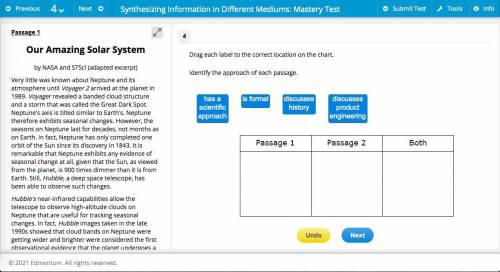
English, 08.10.2021 19:10 jennemylesp19oy5
Drag each label to the correct location on the chart.
Identify the approach of each passage.
- has a scientific approach
- is formal
- discusses history
- discusses product engineering
Passage 1
Our Amazing Solar System
by NASA and STScI (adapted excerpt)
Very little was known about Neptune and its atmosphere until Voyager 2 arrived at the planet in 1989. Voyager revealed a banded cloud structure and a storm that was called the Great Dark Spot. Neptune's axis is tilted similar to Earth's. Neptune therefore exhibits seasonal changes. However, the seasons on Neptune last for decades, not months as on Earth. In fact, Neptune has only completed one orbit of the Sun since its discovery in 1843. It is remarkable that Neptune exhibits any evidence of seasonal change at all, given that the Sun, as viewed from the planet, is 900 times dimmer than it is from Earth. Still, Hubble, a deep space telescope, has been able to observe such changes.
Hubble's near-infrared capabilities allow the telescope to observe high-altitude clouds on Neptune that are useful for tracking seasonal changes. In fact, Hubble images taken in the late 1990s showed that cloud bands on Neptune were getting wider and brighter were considered the first observational evidence that the planet undergoes a change of seasons.
In 2002, astronomers using Hubble noted that the abundance of high-altitude clouds increased the planet's brightness from observations made in the late 1990s. Astronomers consider this brightness increase a sign of seasonal change. Hubble studies show that Neptune has a nearly constant brightness at low latitudes (near the equator). This supports the idea that the observed changes are seasonal in nature, because seasonal effects would be minimal near the equator and most evident at high latitudes.
Passage 2
About the Hubble Space Telescope
by NASA and STScI (excerpt)
Orbiting 360 miles above Earth, the Hubble Space Telescope is positioned high above the blurring effects of the atmosphere. From this vantage point, it captures images with 10 times the typical clarity of any ground-based telescope and views not only visible light, but also wavelengths1 of near-infrared and ultraviolet light that cannot reach Earth's surface. To operate from orbit, the observatory works like any other scientific or imaging spacecraft; it converts the optical data it collects into electrical signals that are transmitted back to Earth. It must also withstand the airless, high-radiation, and harsh thermal environment of space.
Unlike most other spacecraft, however, Hubble was designed to be serviced periodically by astronauts and so was built with modular components that are astronaut-friendly to handle and replace. This design strategy has enabled it to operate longer than ordinary spacecraft and to benefit from the technological advancements of the last two decades. Astronauts have visited the telescope five times to upgrade its computers, mechanisms, and instruments. These servicing missions have kept the observatory at the forefront of discovery by providing it with increasingly sensitive and accurate components. The last of these servicing calls was in May 2009.
1. the distance between one light wave from any one point to the next point of corresponding phase


Answers: 1


Other questions on the subject: English

English, 21.06.2019 15:00, torioricker
How many times do you read a text when you use the close reading model? will mark brainliest
Answers: 1

English, 21.06.2019 15:10, Jessicadiaz8602
Describe a theme that the author develops through these two excerpts. then analyze how the two excerpts interact and build on one another to develop this theme. be sure to use specific details from the text to support your ideas.
Answers: 2

English, 21.06.2019 20:50, lemonsalt9378
Use the dictionary entry for crude to answer the question crude use context clues to choose the sentence that best uses the fourth definition of the word crude. crude ['krüd) adj from latin crudus 1. the quality of being unchanged from the original state 2. the quality of being primitive or uncultured 3. the quality of being obvious 4. the quality of being rough in execution rather than being subtle, selma was rather crude in the way she conducted herself at the meeting. elijah and his brother quickly built a crude shelter that would keep them warm and dry through the night. thelma's knowledge of art and poetry showed the rest of the diners that she was far from crude. there was oil to be found on the property, but it was crude and would need to be processed. mark this and return save and exit next submit
Answers: 2

English, 21.06.2019 22:30, SavyBreyer
"where are you taking me? " the car hesitated, or rather gave a faint whirring click, as if information, somewhere, was dropping card by punch- slotted card under electric eyes. "to the psychiatric center for research on regressive tendencies." he got in. the door shut with a soft thud. the police car rolled through the night avenues, flashing its dim lights ahead. which statement best describes the intended aesthetic impact of this excerpt? o a. by showing leonard obeying the police car, the author reinforces the theme of surrendering one s individuality. o b. by relating the way the car responds, the author underscores the theme of the dangers of a mechanized of society o c. by having leonard, a seemingly normal person, taken to a psychiatric center, the author injects irony, leaving the reader surprised o d. by showing leonard communicating with another person, the author satisfies his need for human contact, leaving the reader hopeful
Answers: 1
You know the right answer?
Drag each label to the correct location on the chart.
Identify the approach of each passage.
...
...
Questions in other subjects:


Mathematics, 06.01.2021 19:50


Business, 06.01.2021 19:50


Mathematics, 06.01.2021 19:50


English, 06.01.2021 19:50




